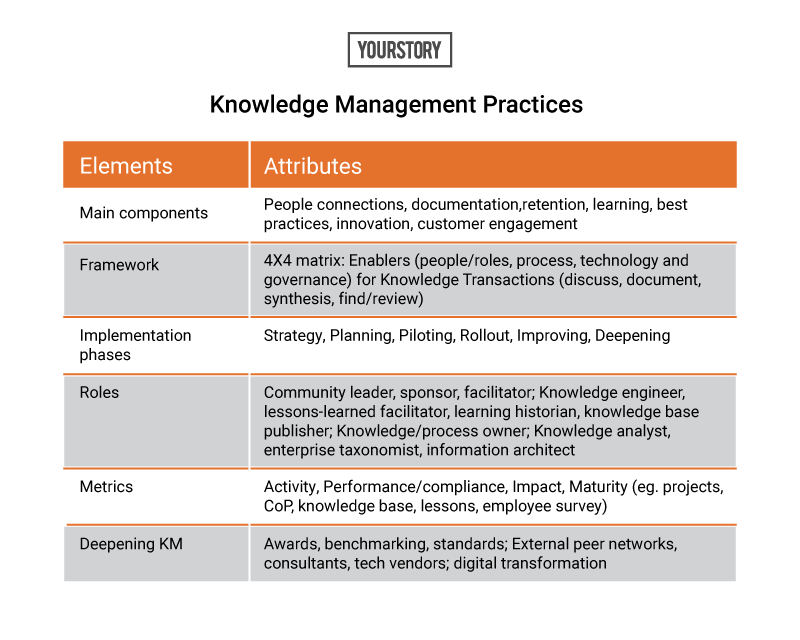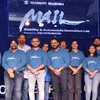Launched in 2012, YourStory's Book Review section features over 270 titles on creativity, innovation, knowledge work, and digital transformation. See also our related columns The Turning Point, Techie Tuesdays, and Storybites.
Over the decades, knowledge management (KM) has emerged as a key discipline for improving productivity, growth, risk management, and innovation in firms around the world. Business leaders looking for a guide to implementing KM can find useful frameworks and case studies in the 2020 edition of The Knowledge Manager’s Handbook by Nick Milton and Patrick Lambe.
Here are my five key clusters of takeaways from this must-have reference book, summarised as well in Table 1. See also my reviews of the related books, Critical Knowledge Transfer, KNOWledge SUCCESSion, The Resilient Organisation, Navigating the Minefield, and my book series The KM Chronicles for KM case studies.
Nick Milton is co-founder of consultancy Knoco, and was at the centre of the team that led KM at BP. He is the author of The Lessons Learned Handbook and Designing a Successful KM Strategy. Patrick Lambe is founding partner of Straits Knowledge; his other books are Organising Knowledge and KM Approaches, Methods and Tools.
The hefty 425-page book is packed with actionable advice and tips, drawn from the authors’ extensive experience. The material is backed by global surveys on KM conducted by Knoco, and illustrated with useful figures on KM approaches, success factors, budgets, frameworks, influencing techniques, benefits maps, and metrics reporting.
See also YourStory’s 15-part article series as a media partner for CII’s Global Knowledge Summit 2020: Knowledge Leadership, KM in the Age of AI, Gamification, Storytelling, Knowledge Sharing in the COVID-19 Era, and Eye on AI.

YourStory moderated the summit panel on Knowledge Excellence: Winners of the Global MIKE Awards, and published profiles of the Most Innovative Knowledge Enterprise (MIKE) Award winners: EY, Tata Steel, Cognizant Technology Solutions, Afcons Infrastructure, Petroleum Development Oman, BINUS University (Indonesia), and Mobarakeh Steel Company (Iran).
I. Foundations
The book describes a practical roadmap to KM implementation, and is not intended to be an academic discourse. Intangible business assets include knowledge, quality, brand, customer relationships, safety, diversity and talent, the authors begin.
Learning, collaboration and organisational memory are business manifestations of KM. Metaphors for KM include supply chains, orchestras or gardens. KM practices should cover content, connections and conversations, and span codified (explicit), as well as implicit knowledge.
The authors recommend that KM implementations be based on pilots and an opportunistic focus on quick wins, which can help build a long-term plan. The pilot should use a “minimum viable KM framework” or prototype, similar to the MVP in the startup world. For example, a telephone conferencing call can be an MVP to a portal-based CoP.
“KM needs to be delivered where the critical knowledge lies and where the high-value decisions are made,” the authors advise. The size of the company impacts KM team size, budgets, results periods, and returns.
The KM Steering Team should represent the main functions (e.g. quality, HR, IT) as well as main lines of business (e.g. production, marketing, sales), and members should be engaged as partners. The KM team should also interact with other policymakers and functions like corporate librarians and compliance heads.
The KM audit should span existing relationships, documented knowledge, skills, experience, and natural talent. It should unearth risks and gaps.
The KM framework should be balanced and not skewed towards just one type of transaction. For example, there should not be over-reliance on tools and technologies though they are useful. This includes portals, wikis, enterprise social media, people-finder systems, lessons management systems, search, tagging, metadata, taxonomies, and knowledge bases.
“KM is a programme of organisational change,” the authors emphasise. To change people’s mindset, priorities, routines, and habits, one needs to win over hearts and minds. KM should appeal to not just enthusiasts but also to the broader workforce and sceptics.
The authors lay out the steps of the “KM buy-in ladder,” such as awareness, understanding, trial, adoption, and embedding. A useful figure on influencing techniques maps out approaches like reasoning, inspiring, social proof, and invoking higher authority.
In addition to functional roles, key positions are the Chief Knowledge Officer (CKO) and the network of KM Champions. Champions play an important role in advocacy and brokering, and should be effective communicators. A special CoP should be set up to given them support and a sense of identity.
The authors explain that KM is successfully embedded when the KM roles and KPIs are formalised, processes and tools are integrated into workflow, and KM values and policies are part of the governance structure.
The second edition of the handbook has additional material on digital transformation, new case studies, and some analysis of the KM standard ISO 30401:2018. More material on how KM relates to innovation management would have been a welcome addition, as well as an integrated reference section pulling together the sources from all chapters.
II. Obstacles and challenges
The KM journey is not always smooth, and the authors list a number of barriers and stumbling blocks. These include the lack of leadership support, role clarity, understanding of benefits, and cultural issues.
KM should be aligned with business needs and embedded into workflows, the authors recommend. KM jargon should be avoided, and normal business language used instead. Special events should be held to celebrate and reward exemplary knowledge-sharing behaviours.
Effective communication for change requires understanding cultural parameters and archetypes. This includes squirrels (hoarders) and lone heroes, as well as mindsets of short-term action instead of long-term holistic views.
Another mindset to be overcome is the “not invented here” syndrome. Some companies also feel they are already doing KM anyway, or that people are too busy to do the “additional work” that KM requires, or that KM is simple and can quickly deliver results.
Sometimes, knowledge experts may not be good communicators. Some people may fear that giving up their knowledge will make them dispensable, or that others may take credit for it. A culture of blame and shame can be an impediment to the sharing of failure stories and mistakes.
High churn in the KM team can also hamper roll-out and long-term stability of KM. Some key relationships will have to be built again and momentum regained.
III. Impacts and metrics
The authors show how KM benefits mapping should connect KM components to business changes and outcomes, ultimately delivering on strategic goals like growth, profit, and sustainability. For example, a CoP and wiki on sales in emerging markets can yield best practices for growth in new markets, while a customer forum can improve staff retention and thereby improve sustainability.
The authors divide metrics into four types, which can be captured in dashboards. Activity metrics include the frequency of usage of tools and forums. Performance metrics capture compliance as well as outstanding behaviours.
Impact metrics for KM include a reduction in time to find information, onboarding, and project costs; or increase in quality, sales volume, and customer satisfaction. “The amount of value which KM can generate is often far greater than we realise,” the authors observe.
Maturity metrics look at larger phases or stages in the big picture, such as CoP growth in steps like coalescing, maturing, and stewardship. Some metrics require longer reporting cycles, the authors caution. Ultimately, metrics should also serve as points of reflection and learning.
IV. Examples and case studies
Each chapter in the book illustrates the above principles with brief corporate profiles; the final section includes seven larger case studies.
For example, HP’s “KM Stars” programme awards one star for those who offered knowledge and five stars for those who re-used knowledge, thus promoting knowledge re-use. Overall, winners had to write a short story of how they got to win their stars.
Conoco’s Archimedes awards for KM are in four categories: Give (valuable knowledge), Grab (reuse), Gather (CoP), and Guts (sharing lessons from failure).
Tearfund, which provides aid in response to disasters, shared lessons from its Bangladesh flood activities with the team responding to the Orissa cyclone in India. Toyota’s product development system combines lean manufacturing and KM.
Construction company Fluor held a “Knowvember” campaign to collect and spread success stories of knowledge-sharing to reduce response times for fixing leakages. The UN’s Joint Inspection Unit led a KM review and recommended ways to renew KM.
The Finnish Parliament committed to being an “open and competent knowledge organisation with a cooperation-oriented work culture and the capacity and will to learn”. Singapore’s Immigration and Customs Authority used automation to speed up or take over routine activities and let officials focus on high-value work.
Confectionery giant Mars’ KM initiative from 2003-2011 began with a focus on demonstrable effects in key strategic areas. Sales was chosen as a function with a strong pull factor for KM.
The KM initiative was effectively branded with a logo, team colours, and brochures. Success factors included inter-personal skills and “political agility” of the KM team. KM has been reinforced through successive training, and benefits are continually communicated.
NASA has a resilient “federated” KM programme across its head office and nine centres. Its KM journey began in 1999, and was marked by a call for better lessons learnt from its Challenger and Columbia accidents.
KM is supported by CKOs and a KM Policy document, along with initiatives like Pause and Learn, engineering CoPs, video-based stories, internal crowdsourcing for innovation, annual safety reports, and lessons learned programmes for its Apollo projects.
Petroleum Development Oman tied some of its productivity and safety KM steps to the ISO standard on KM. It has an overall KM Framework, Code of Practice, Learning Knowledge Base, KM Steering Group, and Information and Digitalisation Directorate.
Knowledge conveyance and transformation also take place through knowledge cafes, Launch and Learn sessions, storytelling, and knowledge cards. KM is supported right from the top, and its ‘4 Cs’ of KM are connections, collaboration, collection, and culture. Benefits have been realised through cost savings as well as cost and risk avoidance.
Another oil company (name not revealed in the book) tied knowledge sharing to its annual bonus programme. CoPs and platforms had network leaders and wiki moderators; community discussions ended with the creation of reusable documents. Independent actions on complicated tasks without community discussions were frowned upon.
Huawei uses KM for R&D in manufacturing as well as delivery to telecom carriers. KM helps employees learn quickly and also helps frontline staff get knowledge from headquarters. As a result, the number of trips needed by engineers to install base stations reduced from 22 to eight.
KM goals were defined by the “three ones” – one minute (to find knowledge), one day (to get questions answered in a CoP), and one month (to capture knowledge from a frontline project). Micro-interviews, quality content, monthly bulletins, and sharing of success stories are other KM elements.
Connection to experts is also key. A Chinese proverb is particularly relevant in this regard: You can learn more in one sitting with a wise man than ten years of reading books.
Singapore’s Youth Olympic Games Organising Committee, operating under tight time constraints, leveraged KM in the form of learn-as-you-go processes, standardised vocabulary, document management discipline, toolkits and manuals, and during-action review (DAR).
At the conclusion of the games, knowledge was shared with the organisers of the next international games as well as with Singapore government agencies. Thus, the focus was on immediate work benefits as well as long-term legacy.
In the period 2007-2017, KM at the Public Works Department of Malaysia tackled knowledge silos, brain drain, and incomplete information. Exit interviews, handbooks, lessons guides, expert talks, and an e-learning platform were implemented.
V. The road ahead
One section of the book shows ways in which companies with established KM practices are deepening their KM programmes. For example, there are a number of industry and professional awards, but the authors urge companies to carefully look at the underlying bias and conditions.
The new ISO standard for KM has been developed as a “management system” standard, with specifications on KM policy, culture, and improvement. However, external auditors may not be well-versed with the organisation’s unique context for its KM framework, the authors caution.
One chapter explores the relationship between KM and digital transformation technologies like artificial intelligence, big data, and cloud computing. Contributions include smarter products, automation, self-service, and decision-making.
See also my reviews of the related books Prediction Machines; Seeing Digital; A Human's Guide to Machine Intelligence; Machine, Platform, Crowd; The AI Advantage; and Human + Machine.
AI works well in clearly-understood scenarios and routine tasks with large, clean datasets. But it does not work as well in situations where there is “experience-based knowledge, knowledge-carrying relationships, and/or natural talent,” the authors caution.
The authors end by urging companies to share their own KM lessons so that others can benefit in their journeys as well. “Knowledge management implementation will remain a priority for organisations around the globe for decades to come,” they sign off.
Edited by Saheli Sen Gupta
India’s most prolific entrepreneurship conference TechSparks is back! With it comes an opportunity for early-stage startups to scale and succeed. Apply for Tech30 and get a chance to get funding of up to Rs 50 lakh and pitch to top investors live online.
Link : https://yourstory.com/2020/10/knowledge-management-productivity-risk-handbook
Author :- Madanmohan Rao ( )
October 13, 2020 at 07:30AM
YourStory



